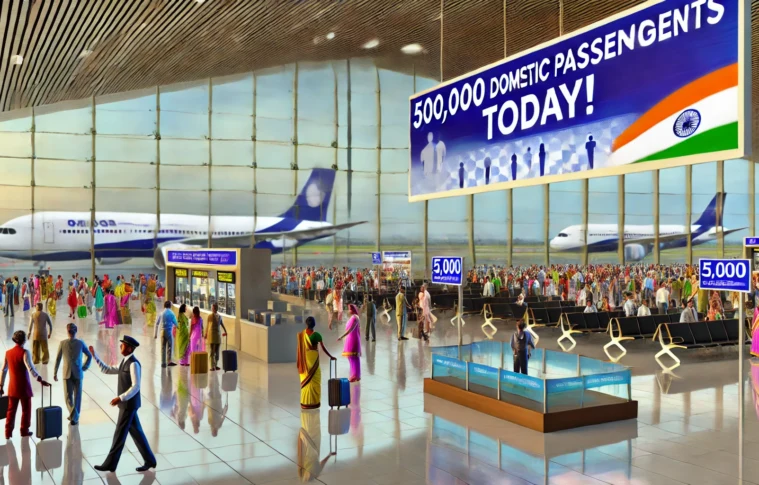India’s aviation sector has achieved a remarkable milestone, transporting over 500,000 domestic passengers in a single day. This record, set in November 2024, highlights the industry’s robust recovery and sustained growth post-pandemic. The surge in air travel demand showcases India’s growing economic activity, rising disposable incomes, and an increasingly mobile population.
With this feat, the Indian aviation industry solidifies its position as one of the fastest-growing aviation markets globally.
Breaking Down the Milestone
- Total Domestic Passengers: Over 500,000 in a single day.
- Airline Contributions: Major carriers like IndiGo, Air India, SpiceJet, and Vistara played key roles.
- Busiest Routes:
- Delhi-Mumbai
- Bengaluru-Hyderabad
- Chennai-Kolkata
This achievement reflects strong demand for both leisure and business travel, driven by festive season travel and an expanding middle class.
Key Drivers Behind the Record
- Festive Season Demand:
- The post-Diwali travel surge significantly contributed to the spike in passenger numbers.
- Families and individuals took advantage of long weekends and holiday breaks.
- Affordable Airfares:
- Price competition among airlines made flying more accessible to a broader segment of the population.
- Introduction of discount schemes and last-minute deals further incentivized travel.
- Rise in Regional Connectivity:
- Government initiatives like UDAN (Ude Desh ka Aam Naagrik) have enhanced connectivity to Tier 2 and Tier 3 cities, driving growth in smaller markets.
- Resurgence of Business Travel:
- Increased corporate activity post-pandemic has boosted demand for air travel among professionals.
Airline Performance and Contributions
India’s leading airlines played a crucial role in achieving this milestone:
- IndiGo:
- As the market leader, IndiGo accounted for nearly half of the total passenger count.
- Its wide network and operational efficiency were key contributors.
- Air India:
- Focused on expanding its domestic routes alongside its international ambitions.
- SpiceJet and Go First:
- Continued to leverage regional routes and price-sensitive travelers.
- Vistara:
- Positioned as a premium carrier, it saw strong demand on metro routes.
Growth of Regional Aviation
Regional aviation has been a game-changer for the industry:
- UDAN Scheme Success:
- The government’s regional connectivity program has added over 400 new routes since its inception.
- Small towns now have access to air travel, fueling passenger growth.
- Infrastructure Expansion:
- Development of new airports and modernization of existing ones under the National Civil Aviation Policy has improved capacity and efficiency.
- Low-Cost Airlines:
- Budget carriers are capitalizing on regional routes, attracting first-time flyers.
Impact of Technology on Passenger Experience
Advancements in technology have streamlined operations and enhanced passenger experiences:
- Digital Check-ins: Reduced wait times at airports.
- Real-Time Flight Updates: Improved communication with travelers.
- AI-Powered Operations: Optimized flight schedules and resource management.
- Enhanced In-Flight Connectivity: Boosted passenger satisfaction during travel.
Challenges Facing the Aviation Industry
Despite this milestone, the aviation sector faces several challenges:
- Rising Fuel Costs:
- Aviation turbine fuel (ATF) prices remain a significant burden for airlines.
- Infrastructure Strain:
- Rapid passenger growth is testing the capacity of existing airports, especially in metro cities.
- Pilot Shortage:
- The demand for skilled pilots has outpaced supply, potentially impacting operations.
- Environmental Concerns:
- The aviation industry faces increasing scrutiny over its carbon footprint, with a push for sustainable practices.
Future Prospects for Indian Aviation
The record-breaking passenger milestone is a testament to the potential of India’s aviation sector. Moving forward:
- Airport Expansion:
- The government plans to develop 200 airports by 2040, including multiple greenfield projects.
- Sustainability Initiatives:
- Airlines are investing in fuel-efficient aircraft and exploring sustainable aviation fuel (SAF).
- Rise of Tier 2 and Tier 3 Cities:
- As urbanization spreads, smaller cities will contribute a larger share of domestic air travel.
- Fleet Modernization:
- Carriers are upgrading fleets to handle increasing demand and improve fuel efficiency.
Global Implications
India’s aviation milestone has drawn attention worldwide, reinforcing its status as a key player in global aviation:
- Market Growth: India is set to overtake the UK as the third-largest aviation market by 2025.
- FDI Attraction: The growing sector is likely to attract more foreign direct investment (FDI) in airport development and airline partnerships.
Conclusion
India’s aviation industry achieving 500,000 domestic passengers in a single day marks a turning point, reflecting the sector’s resilience and growth potential. With rising connectivity, affordable fares, and expanding infrastructure, the industry is well-positioned to sustain its upward trajectory.
As the skies get busier, India’s aviation story continues to inspire and lead the way in transforming travel for millions.



